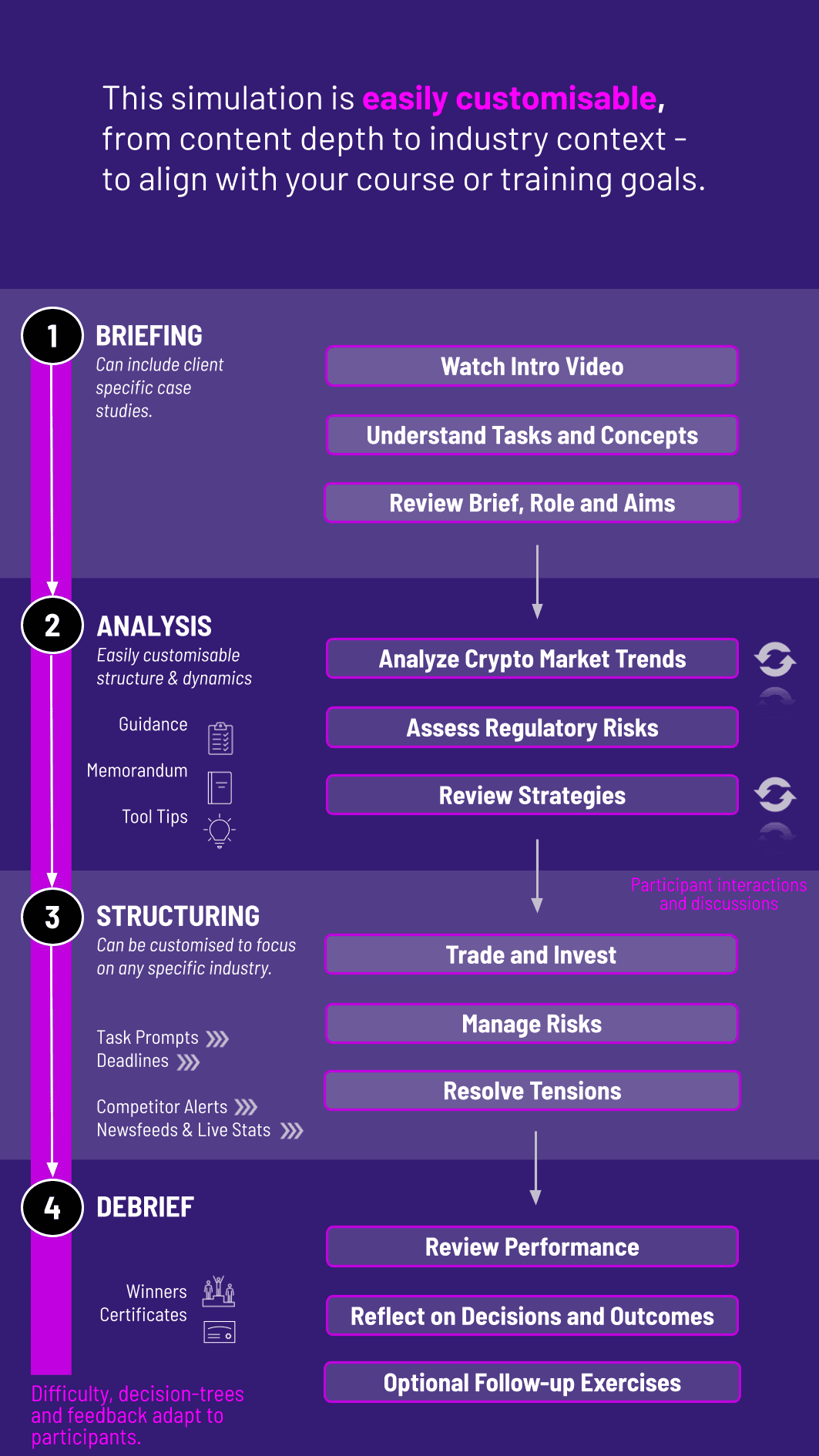
In this simulation, participants act as investors, regulators, and entrepreneurs navigating digital currency markets - balancing volatility, innovation & strategy while responding to shocks, speculation, and evolving blockchain-driven ecosystems.
Cryptocurrency market dynamics and volatility
Blockchain fundamentals and digital asset design
Initial Coin Offerings (ICOs) and token launches
Regulation, compliance, and global policy differences
Speculative bubbles and investor psychology
Cybersecurity and fraud in crypto markets
Stablecoins, DeFi, and evolving financial innovations
Market liquidity and trading strategies
ESG considerations in crypto mining and sustainability
Long-term adoption vs short-term speculation


Build and manage cryptocurrency portfolios under volatile conditions
Evaluate ICOs and blockchain projects for credibility and value
React to news, regulations, and speculative shifts in markets
Negotiate with regulators, investors, or exchanges
Decide between speculation, hedging, and long-term adoption strategies
Reflect on lessons from successes, failures, and missed opportunities
By the end of the simulation, participants will be able to:
Understand cryptocurrency market mechanics and drivers
Balance risk, speculation, and long-term adoption strategies
Evaluate blockchain projects and token economics
Navigate regulatory uncertainty and compliance requirements
Recognize investor psychology in speculative markets
Respond effectively to external shocks and crises
Communicate investment reasoning and risk management approaches
Explore the role of crypto in global finance and innovation
Identify vulnerabilities like fraud, scams, and cyberattacks
Build confidence in applying crypto knowledge to real-world contexts
The simulation’s flexible structure ensures that these objectives can be calibrated to match the depth, duration, and focus areas of each program, whether in higher education or corporate learning.
The simulation can be run individually or in teams in classrooms or corporate workshops. Each cycle represents a decision-making round in crypto markets.
1. Receive a Scenario or Brief: Participants are given a crypto market update with context, objectives, and challenges.
2. Analyse the Situation: They review project fundamentals, market sentiment, and regulatory risks.
3. Make Strategic Decisions: Participants decide on trading, investing, or regulatory responses under time pressure.
4. Collaborate Across Roles: Teams may act as regulators, investors, or entrepreneurs negotiating in the ecosystem.
5. Communicate Outcomes: Participants present investment memos, regulatory updates, or project pitches.
6. Review and Reflect: Feedback highlights portfolio results, project viability, and stakeholder trust. Participants adapt strategies in subsequent rounds.
Do participants need blockchain expertise? No. The simulation introduces key blockchain and crypto concepts in an accessible way.
What roles are included? Investors, regulators, entrepreneurs, and exchanges.
Can scenarios be customized? Yes. They can reflect global markets, regulations, or specific use cases.
Is this simulation focused only on trading? No. It also covers regulation, governance, and long-term adoption.
How long does it run? It can be run as a short 4-hour session or extended into multi-day sessions.
Can it be run online? Yes. The simulation is fully compatible with digital and hybrid learning.
Does it cover fraud and security? Yes. Scenarios include hacks, scams, and investor protection issues.
Is this suitable for executives? Yes. It is widely used in corporate training and executive programs.
How is success measured? By portfolio performance, project evaluation, and stakeholder credibility.
Does it cover DeFi and stablecoins? Yes. Advanced scenarios include DeFi platforms, token design, and stablecoin risks.
Effectiveness in portfolio and project decisions
Judgment in balancing risk, speculation, and adoption
Responsiveness to regulation and market volatility
Clarity in communicating investment strategies
Collaboration and negotiation across roles
You can also include memo writing and debrief presentations as part of the assessment structure. Additionally, you can also add a built-in peer and self-assessment tool to see how participants rate themselves. This flexibility allows the simulation to be easily integrated by professors as graded courses at universities and by HR at assessment centres at companies.
Join this 20-minute webinar, followed by a Q&A session, to immerse yourself in the simulation.
or
Book a 15-minute Zoom demo with one of our experts to explore how the simulation can benefit you.